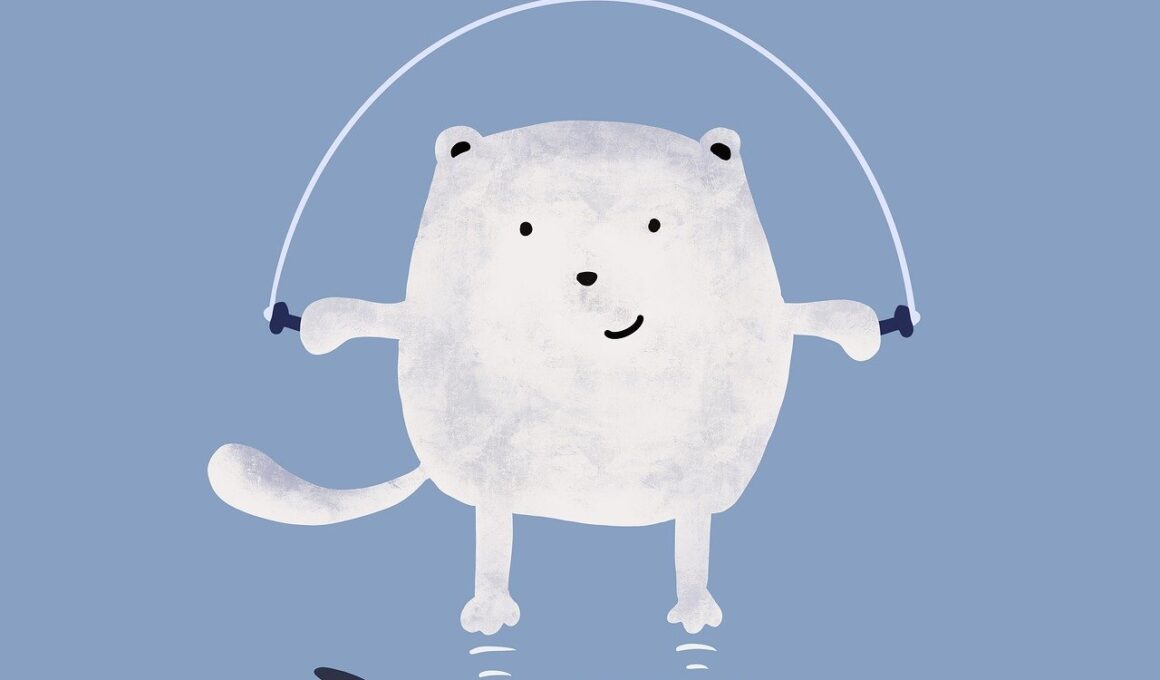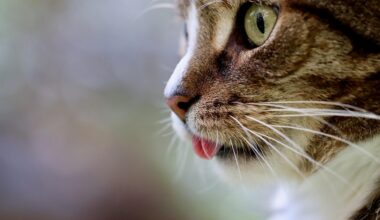Best Practices for Senior Cat Physical Activity
Engaging senior cats in physical activity is crucial for their overall well-being. As cats age, they may become less active. However, structured exercise can help maintain their health and agility. One effective way to introduce exercise is through play. Using interactive toys can entice your senior cat to get moving. Engage them with feather wands, laser pointers, or even toys that mimic prey. You can also introduce gentle games like hide-and-seek. These activities stimulate their instincts while keeping them active. Incorporating regular exercise into their routine not only supports physical health but also enriches their mental stimulation. Consistency is key. Establish set times each day for play sessions to develop a habit. Always keep it fun and light-hearted, as stress can deter them from engaging. Observe your cat’s behavior and energy levels. If they seem fatigued, reduce the intensity or duration. Remember that every cat is unique; adapt the exercise routine according to your senior cat’s preferences and capabilities. Additionally, consult your veterinarian to ensure the activities align with their health conditions or restrictions.
Another essential aspect of encouraging physical activity in senior cats involves creating an enticing environment. You can do this by using vertical spaces like shelves or cat trees. Such setups encourage climbing, promoting exercise while satisfying their natural instincts to ascend. They offer both physical and mental engagement. You could also scatter toys around the house, enticing your cat to explore different areas. Additionally, having scratching posts in various locations helps them stretch and strengthen their muscle. Enriched environments discourage boredom, essential for older cats. Consider using puzzle feeders to encourage slow feeding, combining mental stimulation with movement. This helps curb overeating while encouraging exploration as they search for food. Engage them with interactions like cuddling or gentle brushing, developing trust and comfort. Schedule play sessions that last around 10 to 15 minutes, especially during cooler parts of the day when they’re more active. Gradually increase these sessions as your cat builds endurance. Always monitor their reaction and adjust activities. By fostering an engaging environment, you provide opportunities for healthy exercise, enhancing both physical and mental health.
Monitoring Health During Activities
Monitoring your senior cat’s health during physical activities is critical for ensuring their safety. Before embarking on any exercise routine, consult a veterinarian to evaluate your cat’s health status. This will help identify any underlying conditions that may limit their ability to engage in strenuous activities. Pay attention to their respiratory patterns during play. If they seem excessively tired or wheezing, stop immediately and let them rest. Always observe their behavior for signs of distress or discomfort. Watch for indications they may enjoy certain exercises, such as purring or playful behavior. Limit intense activities to shorter bursts. Older cats can tire quickly, so aim for multiple short sessions throughout the day instead of one long session. Additionally, stay vigilant for any physical changes that may arise, such as limping or difficulty in movement. Regular vet check-ups can also help monitor their weight and mobility. Based on these assessments, adjust their exercise routine accordingly. Healthy exercise habits tailored to their specific needs can greatly enhance their quality of life, extending both their activity levels and lifespan.
Nutrition plays an integral role in the physical health of senior cats, particularly in facilitating their exercise routine. A well-balanced diet ensures they have the energy levels required for engaging in physical activities. Older cats may exhibit different dietary needs, so consulting your veterinarian for tailored nutritional advice is important. They may suggest incorporating higher protein levels to support muscle maintenance. Furthermore, ensure they remain hydrated, particularly before and after exercise sessions. Fresh water should always be available, and consider moist food options if your cat is prone to dehydration. Treats can be a motivator during play, but moderation is essential, especially with senior cats who may struggle with weight management. You can create homemade treats using natural ingredients to maintain flavor while ensuring nutritional value. Maintaining a healthy diet alongside a comprehensive exercise routine can greatly improve their overall health. Improving muscle strength, metabolism, and bone density all lead to longer and healthier lives. Focus on providing a diet that promotes energy and vitality, essential for encouraging an active lifestyle in your beloved feline companion.
Safe Exercise Alternatives
Providing safe exercise alternatives for senior cats ensures they remain active without risking injury. Gentle activities, such as slow-paced strolling, can encourage movement without overwhelming them. Try using a harness and leash for controlled outdoor excursions, allowing fresh air and exploration around your yard. Always start with short walks, gradually increasing distance as they build stamina. Indoor alternatives, like tug-of-war using soft toys, can stimulate their playful nature. Select toys that are lightweight and easy to manipulate, minimizing strain. Simple fetch games using lightweight balls or soft plush toys can also encourage running short distances. For significantly less active cats, consider low-impact exercises such as stretching. Gently stretching their limbs can enhance flexibility and improve circulation. Additionally, supervising your cat’s interactions with other friendly pets encourages social engagement, facilitating gentle play without overexertion. Always monitor their response to activities and adjust accordingly. Keeping workouts short and sweet helps create a positive association with exercise. Providing safe alternatives tailored to their comfort levels will keep your senior cat physically active and mentally engaged.
Additionally, it’s vital to recognize signs of fatigue in your senior cat during exercise routines. Unlike younger felines, older cats may tire more quickly and easily. Learning to identify when your cat has had enough will help prevent overexertion. Signs of fatigue can include excessive panting, a slower pace, or a reluctance to engage. While lots of play would normally excite them, you may notice them gradually slowing or quickly losing interest in their toys. Watch for their ears drooping or tail position, as these can indicate discomfort. It’s crucial to strike a balance between encouraging activity and respecting their limits. After each session, provide plenty of water to keep them hydrated. Consider adding rest days in your routine, allowing them to recharge. As a caregiver, it’s essential to cultivate patience and adapt your expectations based on your cat’s energy levels. Provide affection and encouragement, regardless of whether they exhibited a high level of activity. With time, proper monitoring will help you identify the signs they communicate regarding their needs, ensuring a healthier and happier lifestyle.
Conclusion
Incorporating suitable exercise practices for senior cats is integral to maintaining their health and happiness. As they age, the direct correlation between physical activity and overall health becomes increasingly evident. It’s important to understand that older cats might move slower but can still enjoy activities that keep them engaged. Tailoring the exercise approach to their preferences and health status promotes enjoyable experiences. Armed with the knowledge of unique activities, proper monitoring, nutrition, and engagement can foster a healthy and active lifestyle. The essence lies in maintaining flexibility throughout the routine while ensuring their safety remains paramount. Always remember that while it’s essential to encourage participation, engaging your senior cat in physical activity is about quality rather than quantity. Embrace their quirky nature and celebrate small wins when they indulge in interactive play or explore new toys. Senior cats thrive on routine and knowing what to expect. Understanding their needs develops trust and a strong bond between you and your pet. With careful implementation of the best practices, you contribute to extending your cat’s lifespan while improving their quality of life.
Regular engagement in physical activities enhances your senior cat’s mental well-being, reducing anxiety and promoting vibrancy. A well-cared-for feline not only enjoys its life but forms strong connections with their human companions through shared play. Adapting your activities will allow them to thrive, ensuring they remain active, happy, and healthy to the end of their days. Always foster an enriching environment by stimulating their pleasures and exploring new avenues for engagement. With love and diligence, you can ensure your senior cat continues to experience life with joy and fulfillment, creating lasting memories for both of you together.


